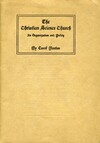Are you sure?
This bookmark will be removed from all folders and any saved notes will be permanently removed.
The Christian Science Church: Its Organization and Polity
The history of the apostolic church and the formation of the Christian Science church compared
Originally published in the 1904 pamphlet titled “The Christian Science Church: Its Organization and Polity”
A careful study of the writings of Mrs. Eddy, including the Mother Church Manual, reveals the significant fact that the general structure and formation of the Christian Science church, its polity and institutional nature, are in marked accord with the Apostolic Christian Church; this is especially interesting in view of the fact, as history shows, that the religion of Jesus was a fulfilment of the law and prophets of Judaism, and that during the first two or three centuries of its existence it healed both the sick and sinful, controlled the elements, and raised the dead.
Christian Science as a system is thoroughly abreast of the times in which we live. It heals all types of organic and functional disease, saves through regeneration the sinner, and enlightens the spiritually ignorant. It interprets the sacred Scriptures of Jew and Christian, and unites in theory and practice the Ten Commandments and the Sermon on the Mount. It is a religion of works,—humane, liberal, logical, and provable. As an organized movement or church, it presents much of interest to the student of present religious development and expansion.
The growth of democracy in the State has prefaced democracy in the Church of Christ on earth, and the widespread return to the moral-spiritual authority of Jesus has tended toward a modern revival of early church rule and government. The simple organization of the immediate followers of Jesus by a process of development in administrative detail became gradually arbitrary, ecclesiastical, and complex. Like the evolution of the New Testament canon, the development of the Christian Church as a whole came degrees and amidst the contention of differing schools of religion and Biblical interpretation. Oral statement, based upon the trained memory of the disciples of Jesus as personal hearers of his teaching and witnesses of his work, had been recorded but a short time, in what we know and study as the Gospels, when personal interpretations of the Master's meaning began to multiply, and the long history of doctrines and dogmas was inaugurated. Christian scholarship generally places the writing of the four Gospels in the latter part of the first century the Pauline epistles and other books following closely after. The Apocalypse was the last book to be accorded a place in the New Testament canon, though its authorship is generally conceded to be the same as that of the fourth Gospel.
Enjoy 1 free Sentinel article or audio program each month, including content from 1898 to today.
JSH Collections
This article is included in:
1904 - PAMPHLET
The Christian Science Church: Its Organization and Polity
JSH-Online has hundreds of pamphlets, anthologies, and special editions for you to discover.



